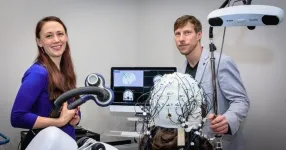Hear ye! Hear ye! Yale researchers uncover new complexities in human hearing
2025-01-27
(Press-News.org) New Haven, Conn. — Yale physicists have discovered a sophisticated, previously unknown set of “modes” within the human ear that put important constraints on how the ear amplifies faint sounds, tolerates noisy blasts, and discerns a stunning range of sound frequencies in between.
By applying existing mathematical models to a generic mock-up of a cochlea — a spiral-shaped organ in the inner ear — the researchers revealed a new layer of cochlear complexity. The findings offer fresh insight into the remarkable capacity and accuracy of human hearing.
“We set out to understand how the ear can tune itself to detect faint sounds without becoming unstable and responding even in the absence of external sounds,” said Benjamin Machta, an assistant professor of physics in Yale’s Faculty of Arts and Science and co-senior author of a new study in the journal PRX Life. “But in getting to the bottom of this we stumbled onto a new set of low frequency mechanical modes that the cochlea likely supports.”
In humans, sound is converted into electrical signals in the cochlea. People are able to detect sounds with frequencies across three orders of magnitude and more than a trillion-fold range in power, down to tiny vibrations of air.
Once sound waves enter the cochlea, they become surface waves that travel along the cochlea’s hair-lined basilar membrane.
“Each pure tone rings at one point along this spiral organ,” said Asheesh Momi, a graduate student in physics in Yale’s Graduate School of Arts and Sciences and the study’s first author. “The hair cells at that location then tell your brain what tone you are hearing.”
Those hairs do something else as well: They act as mechanical amplifiers, pumping energy into sound waves to counteract friction and help them reach their intended destinations. Pumping in just the right amount of energy — and making constant adjustments — is crucial for precise hearing, the researchers said.
But that is simply one set of hearing modes within the cochlea, and it is well-documented. The Yale team discovered a second, extended set of modes within the organ.
In these extended modes, a large portion of the basilar membrane reacts and moves together, even for a single tone. This collective response places constraints on how hair cells respond to incoming sound and how the hair cells pump energy into the basilar membrane.
“Since these newly discovered modes exhibit low frequencies, we believe our findings might also contribute to a better understanding of low-frequency hearing, which is still an active area of research,” said Isabella Graf, a former Yale postdoctoral researcher who is now at the European Molecular Biology Laboratory in Heidelberg, Germany.
Graf and Machta have collaborated on a series of studies in recent years that used mathematical models and statistical physics concepts to better understand biological systems, such as a pit viper’s sensitivity to temperature change and the interplay between phases of matter that come into contact within cell membranes.
Michael Abbott of Yale and Julian Rubinfien of Harvard are co-authors of the new study. Machta, Momi, and Abbott are part of Yale’s Quantitative Biology Institute.
The research was supported by the National Institutes of Health, a Simons Investigator award, and the German Research Foundation.
# # #
END
ELSE PRESS RELEASES FROM THIS DATE:
2025-01-27
Marilyn R. Gugliucci, MA, PhD, FAGHE, FGSA, AGSF, FNAOME, of the University of New England (UNE) College of Osteopathic Medicine (COM) has been installed as the new president of the Gerontological Society of America (GSA), the nation’s largest interdisciplinary organization devoted to the field of aging. She was elected by GSA’s membership, which consists of 6,000 researchers, educators, practitioners, and other professionals.
Gugliucci is the 81st person to hold the office since the Society was founded in 1945. As president, she will oversee matters of GSA’s governance and strategic planning, while also managing the program for GSA’s 2025 Annual Scientific Meeting. ...
2025-01-27
Giant clams, some of the largest mollusks on Earth, have long fascinated scientists. These impressive creatures can grow up to 4.5 feet in length and weigh over 700 pounds, making them icons of tropical coral reefs.
But these animals don’t bulk up on a high-protein diet. Instead, they rely largely on energy produced by algae living inside them. In a new study led by CU Boulder, scientists sequenced the genome of the most widespread species of giant clam, Tridacna maxima, to reveal how these creatures adapted their genome to coexist with algae.
The findings, published Jan. 4 in the journal Communications Biology, offer ...
2025-01-27
Men and women alike are drawn to younger partners, whether or not they realize it. The conclusion came from a University of California, Davis, study of 4,500 blind dates of people seeking a long-term partner.
“After a blind date, participants were slightly more attracted to younger partners, and this trend was equally true for men and women,” said Paul Eastwick, UC Davis professor of psychology and lead author on the study, published in the journal Proceedings of the National Academy ...
2025-01-27
January 27, 2025
Scientists at UMass Amherst Engineer Plant-based method of Precious Mineral Mining
Their research manipulates the superplant Camelina sativa to accumulate nickel, provide oil for biofuel and clean contaminated soil
AMHERST, Mass. — As unassuming plant—considered a noxious weed by some—may be the key to fueling a green economy in the U.S. University of Massachusetts Amherst scientists are working with Camelina sativa, a member of the mustard family, to enhance a trio of the plant’s superpowers: absorbing ...
2025-01-27
The subject of when early hominins, closely related ancestors to humans, first left Africa to begin their slow dispersal across the globe is a matter of ongoing discussion among anthropologists. The general consensus has been that hominins were present in Eurasia at least 1.8 million years ago, but some ephemeral traces of hominins have hinted at an earlier presence. New evidence by an international team of researchers now pushes that date back to almost 2 million years ago.
This evidence for hominins in Eurasia earlier than ...
2025-01-27
In an international effort, researchers at Western University, the University of Maryland School of Dentistry (UMSOD) and Neuroscience Research Australia (NeuRA) uncovered how specific patterns in brain activity can predict an individual’s sensitivity to pain, expanding opportunities for improved pain management strategies.
The new study was published Jan. 27 in JAMA Neurology. It found the combination of two biomarkers in the brain – corticomotor excitability (CME), excitability in the region of the brain that controls movement, and peak alpha frequency (PAF), a neural marker associated with cognitive performance – can accurately and reliably distinguish high- ...
2025-01-27
ITHACA, N.Y. – In the same way that terrestrial life evolved from ocean swimmers to land walkers, soft robots are progressing, too, thanks to recent Cornell University research in battery development and design.
A modular worm robot and jellyfish demonstrate the benefits of “embodied energy” – an approach that incorporates power sources into the body of a machine, to reduce its weight and cost.
The worm and jellyfish are direct descendants of an aqueous soft robot, inspired by a lionfish and unveiled in 2019, that could store energy and power its applications via a circulating hydraulic fluid – i.e., “robot blood.” Similar blood sustains ...
2025-01-27
Hebrew SeniorLife, New England’s largest nonprofit provider of senior health care and living communities and the only senior care organization affiliated with Harvard Medical School, announces that its Deanna and Sidney Wolk Center for Memory Health has been recognized by the Institute of Healthcare Improvement (IHI) as an Age-Friendly Health System, level 2, Committed to Care Excellence.
To qualify as an Age-Friendly Health System, level 2, the Wolk Center, which provides comprehensive outpatient care related to brain health, cognitive and behavioral problems, and memory loss, whether due to Alzheimer’s disease, other dementias, or other neurological or psychiatric ...
2025-01-27
Absorbing layers have been fundamental to advancements in technologies like energy harvesting, stealth systems, and communication networks. These absorbers efficiently capture electromagnetic waves across broad frequency ranges, enabling the development of sustainable, self-powered devices such as remote sensors and internet of things (IoT) systems. In addition to energy applications, these layers are pivotal in stealth technology, where they minimize radar visibility and enhance the performance of aircraft and naval systems. They also play a crucial role in improving communication networks by reducing ...
2025-01-27
ITHACA, N.Y. – While floating solar – the emerging practice of putting solar panels on bodies of water – is promising in its efficiency and its potential to spare agricultural and conservation lands, a new experiment finds environmental trade-offs.
In the first manipulative field study examining the environmental impacts of floating solar, published in Environmental Science and Technology, researchers found that floating solar panels increased greenhouse gas emissions on small ponds by nearly 27%.
“There ...
LAST 30 PRESS RELEASES:
[Press-News.org] Hear ye! Hear ye! Yale researchers uncover new complexities in human hearing




